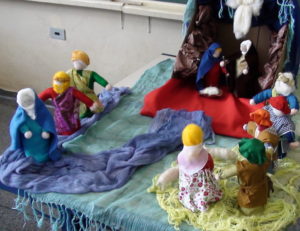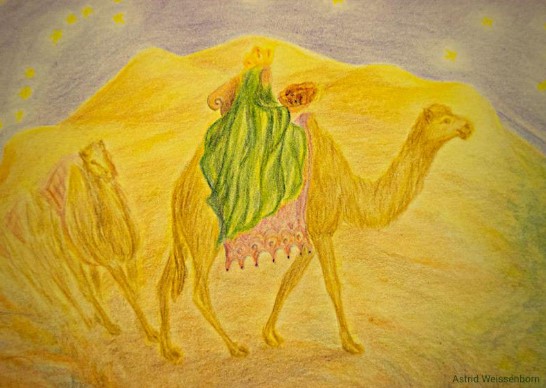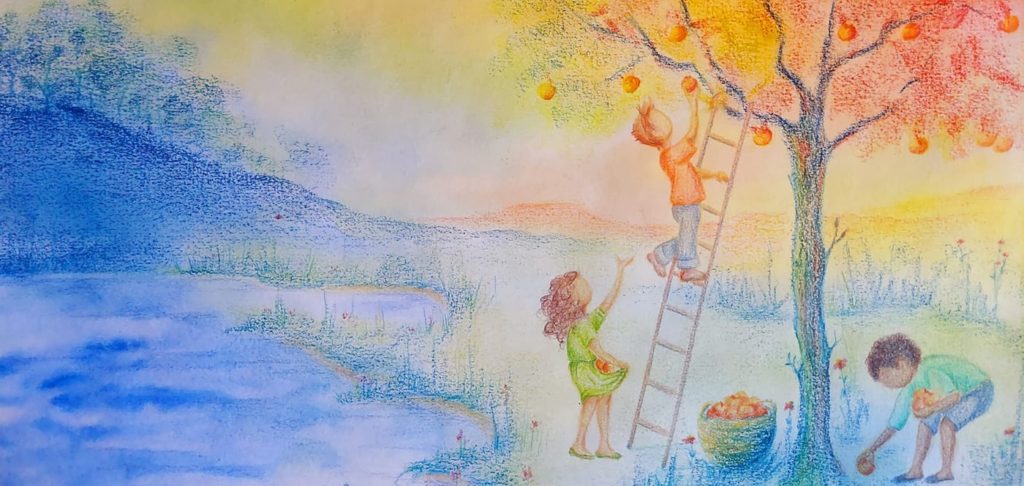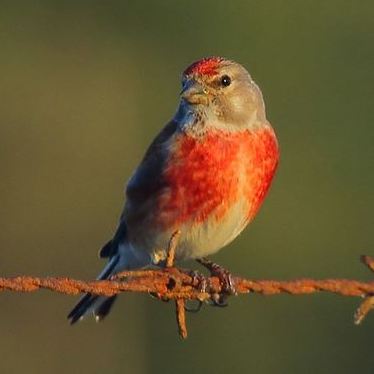Introduction and 7 short stories by Georg Dreissig

Work of teachers from Timburi – SP, during the realization of the Dom da Palavra project.
In the time before Christmas, many families cultivate a beautiful tradition: in the “festival corner” they gradually set up the landscape, in which Maria and José with their donkey go to Belém. In the first week of Advent, only stones are scattered on a brown cloth, with the most beautiful ones forming the way to the Mother of God. In the second week, plants are placed – pine cones and mosses, and also some potted plants such as “palm trees”; – in the third week, the animals – especially the sheep in the meadow – finally, in the fourth week, the men, the shepherds who take care of the sheep.
The emergence of the landscape can be interspersed with small stories that, during the four weeks of Advent, successively introduce the elements of Nature, the kingdom of plants, animals and, finally, human beings. The little book was made to be read. As an Advent calendar that, from story to story, progresses daily and leads up to Christmas Eve, it is well suited for students. For young children it would be good to choose, from each of the four parts, just one story for each week and to tell it for the whole week, perhaps closing it and making it real in the assembled landscape of Advent. , mainly, the joy with the arrival of Christmas. She not only awakened the pleasure of narrating, but, above all, the desire to do it in a child-friendly way, showing that the Christmas event is eagerly awaited throughout the world. Sensitivity must be awakened, from story to story, so that the light of Christmas gradually shines more and more, until on the Holy Night it radiates in all its fullness. Some suggestions I owe to well-known Christmas stories, mainly to the sweet accounts of the Flemish poet Felix Timmermans. The most important thing, however, for the emergence of the collection were, in fact, two bright and amazed children's eyes and two little ears that always wanted to hear more. Georg Dreissig
credits
Realization of the Waldorf School Rudolf Steiner
Original Title: Das Licht in der Laterne – Adventskalender in Geschichten
Author: Georg Dreissig
Title in English: THE LIGHT IN THE LANTERN – An Advent Calendar in Stories
Translators: Ione Rosa Matera Veras, Mariliza Platzer and Edith Asbeck
Typing by Vanessa VB Mendes and Walkiria P. Cavalcanti – March 2013.
Review by Ruth Salles – September 2017.
1. THE STONE PATH TO BELÉM
Mary and Joseph were going to Bethlehem. The donkey trotted excitedly in front of them. Joseph was used to walking and had a good staff; so I could take very firm strides. Mary, the dear Divine Mother, tried her best to keep the same pace. But her delicate feet tapped every now and then on the dark, jagged stones of the path. Even as she clenched her teeth so her pain wouldn't be noticed, a tear slipped from her eyes. The donkey didn't notice, nor did José, who was very busy not making a mistake. The angel, however, who accompanied the three on their journey, noticed that Mary was crying. He leaned towards her and asked, “O dear servant of the Lord, why are you weeping? You are on your way to Bethlehem, where you will give birth to the Divine Child. Does that not give you joy?” Maria replied: “I am very happy to be able to welcome the Child, and I don't want to complain either. Only the dark, pointed stones cut and bruise my feet, so it's hard for me to walk fast.” When the angel heard that, he fixed his resplendent heavenly gaze on the stones, and behold; they transformed. They rounded off their edges and corners, took on beautiful bright colors, and some were even as transparent as glass, sparkling in the light emanating from the Angel.
Mary was then able to walk safely on her bright and colorful road, and no pain again hindered her way to Bethlehem.
2. THE SECRET OF THE BIG STONE
One day, on their way to Bethlehem, Mary and Joseph came across a huge rock. This one was right in the middle of the road and forced travelers to go right or left through the bush, or to climb over it. But there was something very special about this stone. Earlier, when the road was being built, seven strong men had to use all their strength in order to roll the stone aside. But when, the next day, they returned to their work, the huge stone was exactly in its old place, as if it had always been there. Then the strong men spat on their hands and set about their hard work once more. They rolled the big stone out of the way again, and the next day found it again where it had been. This time, the men complained even more. Then, for the third time, they set to work and, using all their strength, removed the stone out of the way. When, however, the next day they found the stone again in its old place, none of the men complained any more, and they asked each other what it meant. Failing to find an answer to their questions, they looked for a holy man, who lived alone in a forest, and told him about the stone that always returned to its old place. The holy man listened attentively, shook his head understandingly, and answered them: “He who is to remove this mighty stone from the path has not yet appeared. Leave it there where it is, and allow it to be rolled from that place by the intended person.” The strong men followed his advice, and so the huge stone remained motionless in the middle of the road, much to the distress of many travelers.
Also Mary and Joseph stopped before the stone. Naturally, José couldn't roll her over, even with the donkey's help. While they thus stood thoughtfully before the obstacle, Joseph accidentally struck the stone with his staff. It was a very light tap. But as soon as the staff touched the stone, it split in half. The two halves fell, one to the right and one to the left of the path. And now it could be seen that the mighty stone had within it a number of crystals, which gleamed wonderfully in the sunlight.
A little later, the holy man also arrived on that road. When he saw the broken stone and the crystals sparking inside, his eyes gleamed: “He who was destined to take the stone out of the way has already appeared.” – he said to himself. And his heart was filled with joy and hope.
3. WHY WATER TURNS TO ICE IN WINTER SEASON
(remembering that the Baby Jesus was born in the northern hemisphere, when it was winter)
One day, on the way to Bethlehem, Mary and Joseph came to a river. This one wasn't too wide, not too deep, but the water at that time of year was freezing. When the donkey plunged his hoof into it, it hurt so much that he quickly pulled it out again, and then there was no way to get him across the river. Nowhere was there a bridge or a boat. What should they do? Joseph was already lifting his cloak to cross the river on foot, carrying Mary on his back. But this Maria did not want to accept, for she feared that the excessive cold would harm her health. Instead, she approached the bank and sang softly, “River wave, ever so smart, stop, stop, be quiet! Form a bridge, form our ground! Then everyone will pass!”
Then, it was as if a delicate tinkle of bells answered from the water, and suddenly the river stopped flowing and formed a bridge, transparent as glass, but so firm that not only Maria, but also José and the donkey could pass her.
Since that day, the water turns to ice in winter. When Mary carried her child on Earth, she was not to be hindered in her path. I should be able to walk safely everywhere.
4. THE MIRACLE AT THE WELL
At that time when José and Maria walked with their donkey to Belém, people still didn't have taps in their homes, the kind you only open when you want water. No, they had to get their buckets, go to the well and draw water from it. Most of the time, it was women and girls who did it. And when they were there, they liked to chat and share the news. That's what Ruth did that night when she picked up her bucket and went to the well. But as she was leaving her house, she noticed a star in the sky that shone so brightly that it overshadowed all the others and even the moon with its brightness. The girl stopped, looking at her admiringly, and forgot about time and what she was going to do. What could that star, which shone so wonderfully, want to announce? Just when her fingers ached from the cold, Ruth woke from her dreams and ran quickly to the well. There was no longer a living soul to be seen. All the other girls were already gone. Quickly, Ruth hung her bucket on the chain to bring it down to the well. But then she hesitated again. Because the mirror of the water shone as if it were pure gold, and that came from the light of that star, which was reflected in the water. “What a glow, what a radiance!” – murmured the girl, ecstatic – “Oh, if Grandma could see this too!”. But the grandmother was at home, sitting in her chair, for her legs had weakened with age and could no longer support her. Carefully, so the glistening water wouldn't churn, Ruth lowered the bucket. But when he later pulled it up, he was astonished that night for the third time; for the water in the bucket also shone like gold. Carefully, the girl dipped her finger into the water and then tasted it: it tasted like it always had. Ruth then took the bucket off the chain and hurried over to her grandmother. “Look at that, Granny!” – she exclaimed, as soon as she opened the door – “Look what I bring you!” And then he showed him the water, which shone as wonderfully as gold. “Look, the water has kept the shining star bright, so you can see it too.” – the girl explained happily. Thoughtfully, the old lady looked at the golden water. Then he asked: “What light is this, which is beginning to shine upon the world, that pure water reflects its brightness without stopping?” – and, turning to Ruth, continued – “And in your eyes, she too has already begun to shine. Take care of her."
The news of the golden water quickly spread throughout the region, and all the people ran to the well to get some. But no matter how much water they removed, it kept its shine. She kept it, yes. But until when? Even when the Child Jesus was born in Bethlehem, and then his light illuminated the world.
5. WHAT WENT IT SINGED TO MARY
Walking into uncharted land was not easy for Maria. She had rarely left Nazaré and, until then, she had never tried asking for an inn at night, or even sleeping on the side of the road. During the day, when the sun gently lit the world and they walked briskly, to get to Bethlehem in time, it wasn't that difficult. But when they went to bed at night, Maria suddenly noticed how heavy her heart was, and the longing tightened her throat. There, in the dark, she thought of Nazareth, of her little house with the roses in the garden and the scent of jasmine under her window; and he remembered the sound the wind made when it passed through the leaves of trees and bushes, or when it drew its waves over the wheat field. Oh yes, for her the wind was her special friend. When he blew in the morning through her open bedroom window, she already knew, before she looked out, what kind of day it was going to be; she knew it through its soft whisper, or its angry breath, through the odors or the wetness it brought to her. But there, on that path, another wind seemed to be blowing, a winter wind, cold and unknown, and so the Divine Mother felt lonelier.
But it's not true: the wind blows wherever it wants. So he also blew around Maria and noticed her sadness. What could I do to comfort her? He was silent for a long time and thought. In fact it was winter, and his duty was to whistle a lot through all the cracks and holes, and howl in all corners. But the dear Divine Mother was in an unknown land, so alone and helpless... And suddenly, the wind began to sing another melody, a song of spring in Nazareth, of the seeds sprouting, of the new leaves appearing, of the wonder of the flowers and the bee hums. So soft and sweet was its spring song that Maria felt warm in her heart and fell asleep with joy.
The good wind! He couldn't help but worry about Mary, the dear Divine Mother. So don't be surprised if it suddenly starts to get warmer before Christmas, to the point where everyone thinks winter is gone. It's just the wind singing its spring song, so Maria won't feel so alone and helpless in a strange land.
6. THE SILVER NEEDLE OF THE MOON AND THE GOLD THREAD OF THE STARS
Full of shy veneration, Joseph looked at his dear wife, who was carrying the Child Jesus in her womb. He did everything he could imagine to make Maria's life lighter and more beautiful. But Joseph was a poor man: dresses and jewelry, which the rich presented to their wives, he could not buy for Mary. This weighed heavily on her at times, although dear Divine Mother never complained that she had nothing to adorn herself with.
Now they were on their way to Bethlehem, and every day they felt, suffering, what it meant to be poor: they went hungry – because they didn’t have money to buy something to eat, and people didn’t give them anything – and they slept in the open, because all the doors of the houses were closed before them. “She is the Divine Mother,” – Joseph always muttered to himself – “and you let her walk around like a beggar.” Almost every day he imagined what he could sell to buy something for Maria, to decorate her and make her happy. But he had nothing that was expendable, except perhaps his staff; and this no one would buy, for Joseph himself had cut it down in the forest.
One night, when they needed to sleep in the open again, José had a dream. He dreamed that a man approached and touched his shoulder. Joseph could tell by the man's clothes that he was very rich. The man, however, did not look at him with contempt, but rather kindly; when Joseph asked him what he could do for him, the stranger replied, “I heard you want to sell your staff. I would like to purchase it.” Amazed, Joseph bent down to pick up the staff, and then he noticed that it was not carved in wood, but artistically wrought from gold and silver. Joseph handed it over to the stranger, and the stranger said, “Now I will also pay for it.” With these words, he stretched out his right hand upwards. Suddenly, the sky began to emit sounds, and the stars sent golden threads down. The man took them and wound them, like a thick ball, around the staff. Then he raised his left hand and... look at this: into it slipped the silver moonboat shape and turned into a silver needle. Then the stranger took the golden ball from the stick and handed the ball and needle to the admired José. “Take this as payment.” - he said. As soon as he spoke those words, he disappeared. Joseph continued to admire the ball of golden threads of the stars and the silver needle of the moon and did not know what to do with them. But then things moved in his hand. Alone, the gold thread was threaded into the silver needle, and by itself, the silver needle began to sew. She sewed, with the golden threads, shining stars on Maria's blue cloak, until she finished the whole ball; so the cloak looked like a copy of the sky. There, the silver needle launched itself again towards the stars and became again the little silver boat of the moon.
Joseph woke up happy the next day. Oh, what a beautiful dream I had! Beside him, he saw lying the wooden staff that that night had been so transformed. Now he was his old staff again, as usual. Then, when his gaze fell on Maria's blue robe, his heart began to leap for joy. For bright stars were sewn with golden threads into the poor robe. Maria was happy too and said, “Oh, now my robe is actually too thin for me!”
This is how Mary, even though Joseph was so poor, was able to wear the beautiful robe of stars of the queen of heaven.
7. THE LIGHT ON THE LANTERN
Titus, the innkeeper, took the lantern, for it was already dark outside. He still wanted to go to the stable, to leave fresh hay there for Remus the ox. When he lit the candle, he noticed that it was already small, almost completely melted. “For a short path it must still last.” he muttered. And went out into the backyard. The soft candlelight chased away the dark of night. Arriving at the stable, Titus hung the lantern on a hook in the ceiling and began his work. He was just putting the fresh hay into the manger when he heard his wife calling out, “Titus, where are you? Guests have arrived!” Then the innkeeper dropped the hay and picked up the lantern. But at that moment, the light flared again very brightly, and then went out. "It doesn't matter," muttered Titus. He left the lantern hanging over the manger, and walked quickly through the dark yard to the house.
The next day, Titus had forgotten about the flashlight. Only at night did he look for her and remember that she must be hanging on the hook above the manger in the stable. Titus looked for a new candle to replace the old one in the lantern. But when he went out into the yard, he saw a soft light shining through the small window of the stable. Amazed, he scratched his head. Who would have turned on that light there? Hadn't he himself seen that she had gone out the night before? He called his wife, for she too should look at that mysterious light. “Weird, isn't it?” he grumbled, as they entered the stable and gazed at the light inside the lantern. "It's just burning for nothing." The woman replied: "Who knows why she doesn't want to go out... It's better not to bother her until she goes out on her own." So it happened that when Mary and Joseph with the donkey were looking for lodging on Christmas Eve, they found the stable already lit up with that soft light. She continued to shine, until the Divine Child was born illuminating the world.
But now you will surely want to know what that mysterious light was, which kept shining in the lantern and didn't even think about going out. No, it really wasn't an ordinary candle. I will reveal to you. A little star had slipped into the lantern. She wanted to be very close when the Divine Child was born. So she secretly slipped into the lantern and glowed there so lovingly. If Titus had looked carefully, he too would have noticed.
credits
Realization of the Waldorf School Rudolf Steiner
Original Title: Das Licht in der Laterne – Adventskalender in Geschichten
Author: Georg Dreissig
Title in English: THE LIGHT IN THE LANTERN – An Advent Calendar in Stories
Translators: Ione Rosa Matera Veras, Mariliza Platzer and Edith Asbeck
Typing by Vanessa VB Mendes and Walkiria P. Cavalcanti – March 2013.
Review by Ruth Salles – September 2017.
***






